Vision Transformers Explained Series
The Math and the Code Behind Attention Layers in Computer Vision
Since their introduction in 2017 with Attention is All You Need¹, transformers have established themselves as the state of the art for natural language processing (NLP). In 2021, An Image is Worth 16×16 Words² successfully adapted transformers for computer vision tasks. Since then, numerous transformer-based architectures have been proposed for computer vision.
This article takes an in-depth look to how an attention layer works in the context of computer vision. We’ll cover both single-headed and multi-headed attention. It includes open-source code for the attention layers, as well as conceptual explanations of underlying mathematics. The code uses the PyTorch Python package.

This article is part of a collection examining the internal workings of Vision Transformers in depth. Each of these articles is also available as a Jupyter Notebook with executable code. The other articles in the series are:
- Vision Transformers, Explained
→ Jupyter Notebook - Attention for Vision Transformers, Explained
→ Jupyter Notebook - Position Embeddings for Vision Transformers, Explained
→ Jupyter Notebook - Tokens-to-Token Vision Transformers, Explained
→ Jupyter Notebook - GitHub Repository for Vision Transformers, Explained Series
Table of Contents
- Attention in General
- Single Headed Attention
- Multi-Headed Attention
- Conclusion
— Further Reading
— Citations
Attention in General
For NLP applications, attention is often described as the relationship between words (tokens) in a sentence. In a computer vision application, attention looks at the relationships between patches (tokens) in an image.
There are multiple ways to break an image down into a series of tokens. The original ViT² segments an image into patches that are then flattened into tokens; for a more in-depth explanation of this patch tokenization see the Vision Transformers article. The Tokens-to-Token ViT³ develops a more complicated method of creating tokens from an image; more about that methodology can be found in the Tokens-To-Token ViT article.
This article will proceed though an attention layer assuming tokens as input. At the beginning of a transformer, the tokens will be representative of patches in the input image. However, deeper attention layers will compute attention on tokens that have been modified by preceding layers, removing the directness of the representation.
This article examines dot-product (equivalently multiplicative) attention as defined in Attention is All You Need¹. This is the same attention mechanism used in derivative works such as An Image is Worth 16×16 Words² and Tokens-to-Token ViT³. The code is based on the publicly available GitHub code for Tokens-to-Token ViT³ with some modifications. Changes to the source code include, but are not limited to, consolidating the two attention modules into one and implementing multi-headed attention.
The attention module in full is shown below:
class Attention(nn.Module):
def __init__(self,
dim: int,
chan: int,
num_heads: int=1,
qkv_bias: bool=False,
qk_scale: NoneFloat=None):
""" Attention Module
Args:
dim (int): input size of a single token
chan (int): resulting size of a single token (channels)
num_heads(int): number of attention heads in MSA
qkv_bias (bool): determines if the qkv layer learns an addative bias
qk_scale (NoneFloat): value to scale the queries and keys by;
if None, queries and keys are scaled by ``head_dim ** -0.5``
"""
super().__init__()
## Define Constants
self.num_heads = num_heads
self.chan = chan
self.head_dim = self.chan // self.num_heads
self.scale = qk_scale or self.head_dim ** -0.5
assert self.chan % self.num_heads == 0, '"Chan" must be evenly divisible by "num_heads".'
## Define Layers
self.qkv = nn.Linear(dim, chan * 3, bias=qkv_bias)
#### Each token gets projected from starting length (dim) to channel length (chan) 3 times (for each Q, K, V)
self.proj = nn.Linear(chan, chan)
def forward(self, x):
B, N, C = x.shape
## Dimensions: (batch, num_tokens, token_len)
## Calcuate QKVs
qkv = self.qkv(x).reshape(B, N, 3, self.num_heads, self.head_dim).permute(2, 0, 3, 1, 4)
#### Dimensions: (3, batch, heads, num_tokens, chan/num_heads = head_dim)
q, k, v = qkv[0], qkv[1], qkv[2]
## Calculate Attention
attn = (q * self.scale) @ k.transpose(-2, -1)
attn = attn.softmax(dim=-1)
#### Dimensions: (batch, heads, num_tokens, num_tokens)
## Attention Layer
x = (attn @ v).transpose(1, 2).reshape(B, N, self.chan)
#### Dimensions: (batch, heads, num_tokens, chan)
## Projection Layers
x = self.proj(x)
## Skip Connection Layer
v = v.transpose(1, 2).reshape(B, N, self.chan)
x = v + x
#### Because the original x has different size with current x, use v to do skip connection
return x
Single-Headed Attention
Starting with only one attention head, let’s step through each line of the forward pass, and look at some matrix diagrams as we go. We’re using 7∗7=49 as our starting token size, since that’s the starting token size in the T2T-ViT models.³ We’re using 64 channels because that’s also the T2T-ViT default³. We’re using 100 tokens because it’s a nice number. We’re using a batch size of 13 because it’s prime and won’t be confused for any of the other parameters.
# Define an Input
token_len = 7*7
channels = 64
num_tokens = 100
batch = 13
x = torch.rand(batch, num_tokens, token_len)
B, N, C = x.shape
print('Input dimensions arentbatchsize:', x.shape[0], 'ntnumber of tokens:', x.shape[1], 'nttoken size:', x.shape[2])
# Define the Module
A = Attention(dim=token_len, chan=channels, num_heads=1, qkv_bias=False, qk_scale=None)
A.eval();
Input dimensions are
batchsize: 13
number of tokens: 100
token size: 49
From Attention is All You Need¹, attention is defined in terms of Queries, Keys, and Values matrices. Th first step is to calculate these through a learnable linear layer. The boolean qkv_bias term indicates if these linear layers have a bias term or not. This step also changes the length of the tokens from the input 49 to the chan parameter, which we set as 64.
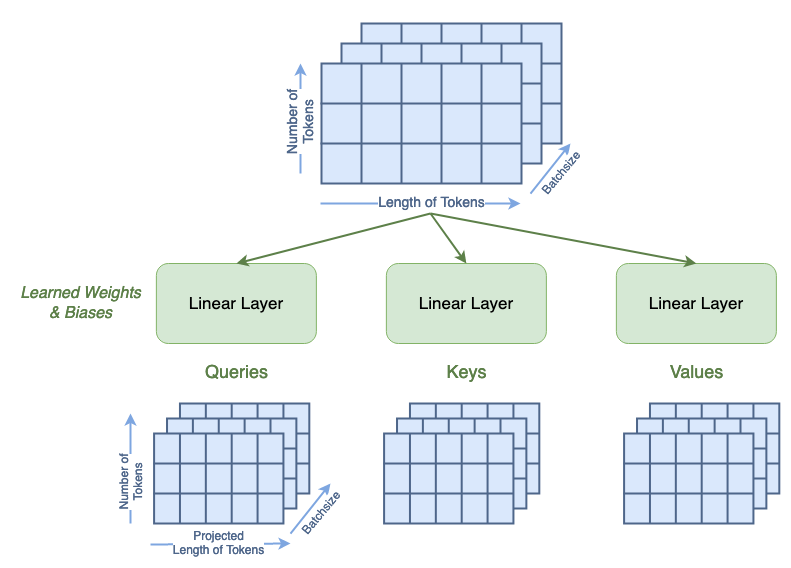
qkv = A.qkv(x).reshape(B, N, 3, A.num_heads, A.head_dim).permute(2, 0, 3, 1, 4)
q, k, v = qkv[0], qkv[1], qkv[2]
print('Dimensions for Queries arentbatchsize:', q.shape[0], 'ntattention heads:', q.shape[1], 'ntnumber of tokens:', q.shape[2], 'ntnew length of tokens:', q.shape[3])
print('See that the dimensions for queries, keys, and values are all the same:')
print('tShape of Q:', q.shape, 'ntShape of K:', k.shape, 'ntShape of V:', v.shape)
Dimensions for Queries are
batchsize: 13
attention heads: 1
number of tokens: 100
new length of tokens: 64
See that the dimensions for queries, keys, and values are all the same:
Shape of Q: torch.Size([13, 1, 100, 64])
Shape of K: torch.Size([13, 1, 100, 64])
Shape of V: torch.Size([13, 1, 100, 64])
Now, we can start to compute attention, which is defined in as:
where Q, K, V, are the queries, keys, and values, respectively; and dₖ is the dimension of the keys, which is equal to the length of the key tokens and equal to the chan length.
We’re going to go through this equation as it is implemented in the code. We’ll call the intermediate matrices Attn.
The first step is to compute:
In the code, we set
By default,
However, the user can specify an alternative scale value as a hyperparameter.
The matrix multiplication Q·Kᵀ in the numerator looks like this:
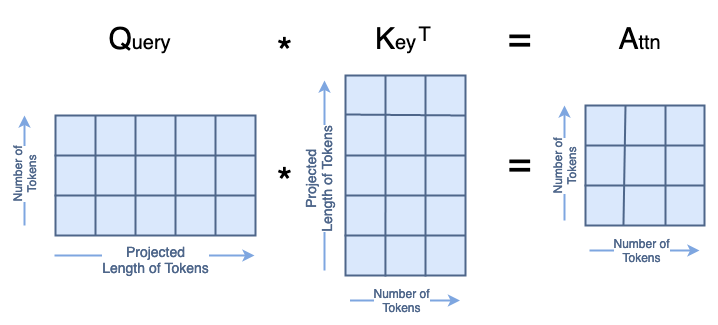
All of that together in code looks like:
attn = (q * A.scale) @ k.transpose(-2, -1)
print('Dimensions for Attn arentbatchsize:', attn.shape[0], 'ntattention heads:', attn.shape[1], 'ntnumber of tokens:', attn.shape[2], 'ntnumber of tokens:', attn.shape[3])
Dimensions for Attn are
batchsize: 13
attention heads: 1
number of tokens: 100
number of tokens: 100
Next, we calculate the softmax of A, which doesn’t change it’s shape.
attn = attn.softmax(dim=-1)
print('Dimensions for Attn arentbatchsize:', attn.shape[0], 'ntattention heads:', attn.shape[1], 'ntnumber of tokens:', attn.shape[2], 'ntnumber of tokens:', attn.shape[3])
Dimensions for Attn are
batchsize: 13
attention heads: 1
number of tokens: 100
number of tokens: 100
Finally, we compute A·V=x, which looks like:

x = attn @ v
print('Dimensions for x arentbatchsize:', x.shape[0], 'ntattention heads:', x.shape[1], 'ntnumber of tokens:', x.shape[2], 'ntlength of tokens:', x.shape[3])
Dimensions for x are
batchsize: 13
attention heads: 1
number of tokens: 100
length of tokens: 64
The output x is reshaped to remove the attention head dimension.
x = x.transpose(1, 2).reshape(B, N, A.chan)
print('Dimensions for x arentbatchsize:', x.shape[0], 'ntnumber of tokens:', x.shape[1], 'ntlength of tokens:', x.shape[2])
Dimensions for x are
batchsize: 13
number of tokens: 100
length of tokens: 64
We then feed x through a learnable linear layer that does not change it’s shape.
x = A.proj(x)
print('Dimensions for x arentbatchsize:', x.shape[0], 'ntnumber of tokens:', x.shape[1], 'ntlength of tokens:', x.shape[2])
Dimensions for x are
batchsize: 13
number of tokens: 100
length of tokens: 64
Lastly, we implement a skip connection. Since the current shape of x is different from the input shape of x, we use V for the skip connection. We do flatten V in the attention head dimension.
orig_shape = (batch, num_tokens, token_len)
curr_shape = (x.shape[0], x.shape[1], x.shape[2])
v = v.transpose(1, 2).reshape(B, N, A.chan)
v_shape = (v.shape[0], v.shape[1], v.shape[2])
print('Original shape of input x:', orig_shape)
print('Current shape of x:', curr_shape)
print('Shape of V:', v_shape)
x = v + x
print('After skip connection, dimensions for x arentbatchsize:', x.shape[0], 'ntnumber of tokens:', x.shape[1], 'ntlength of tokens:', x.shape[2])
Original shape of input x: (13, 100, 49)
Current shape of x: (13, 100, 64)
Shape of V: (13, 100, 64)
After skip connection, dimensions for x are
batchsize: 13
number of tokens: 100
length of tokens: 64
That completes the attention layer!
Multi-Headed Attention
Now that we’ve looked at single headed attention, we can expand to multi-headed attention. In the context of computer vision, this is often called Multi-headed Self Attention (MSA). This section isn’t going to go through all the steps in as much detail; instead, we’ll focus on the places where the matrix shapes differ.
Same as for a single attention head, we’re using 7∗7=49 as our starting token size and 64 channels because that’s the T2T-ViT default³. We’re using 100 tokens because it’s a nice number. We’re using a batch size of 13 because it’s prime and won’t be confused for any of the other parameters.
The number of attention heads must evenly divide the number of channels, so for this example we’ll use 4 attention heads.
# Define an Input
token_len = 7*7
channels = 64
num_tokens = 100
batch = 13
num_heads = 4
x = torch.rand(batch, num_tokens, token_len)
B, N, C = x.shape
print('Input dimensions arentbatchsize:', x.shape[0], 'ntnumber of tokens:', x.shape[1], 'nttoken size:', x.shape[2])
# Define the Module
MSA = Attention(dim=token_len, chan=channels, num_heads=num_heads, qkv_bias=False, qk_scale=None)
MSA.eval();
Input dimensions are
batchsize: 13
number of tokens: 100
token size: 49
The process to computer the Queries, Keys, and Values remains the same as in single-headed attention. However, you can see that the new length of the tokens is chan/num_heads. The total size of the Q, K, and V matrices have not changed; their contents are just distributed across the head dimension. You can think abut this as segmenting the single headed matrix for the multiple heads:
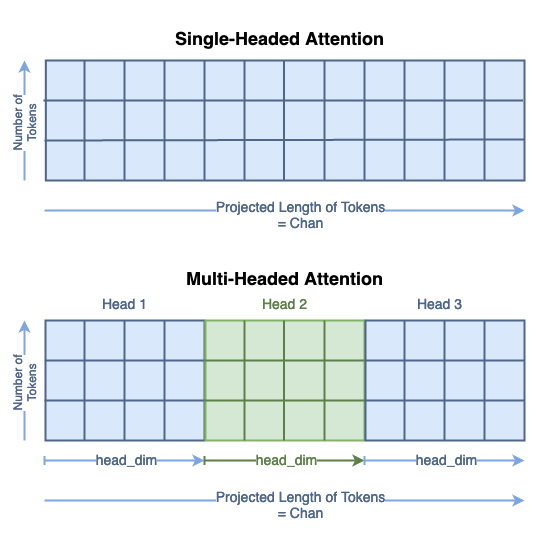
We’ll denote the submatrices as Qₕᵢ for Query head i.
qkv = MSA.qkv(x).reshape(B, N, 3, MSA.num_heads, MSA.head_dim).permute(2, 0, 3, 1, 4)
q, k, v = qkv[0], qkv[1], qkv[2]
print('Head Dimension = chan / num_heads =', MSA.chan, '/', MSA.num_heads, '=', MSA.head_dim)
print('Dimensions for Queries arentbatchsize:', q.shape[0], 'ntattention heads:', q.shape[1], 'ntnumber of tokens:', q.shape[2], 'ntnew length of tokens:', q.shape[3])
print('See that the dimensions for queries, keys, and values are all the same:')
print('tShape of Q:', q.shape, 'ntShape of K:', k.shape, 'ntShape of V:', v.shape)
Head Dimension = chan / num_heads = 64 / 4 = 16
Dimensions for Queries are
batchsize: 13
attention heads: 4
number of tokens: 100
new length of tokens: 16
See that the dimensions for queries, keys, and values are all the same:
Shape of Q: torch.Size([13, 4, 100, 16])
Shape of K: torch.Size([13, 4, 100, 16])
Shape of V: torch.Size([13, 4, 100, 16])
The next step is to compute
for every head i. In this context, the length of the keys is
As in single headed attention, we use the default
though the user can specify an alternative scale value as a hyperparameter.
We end this step with num_heads = 4 different Attn matrices, which looks like:
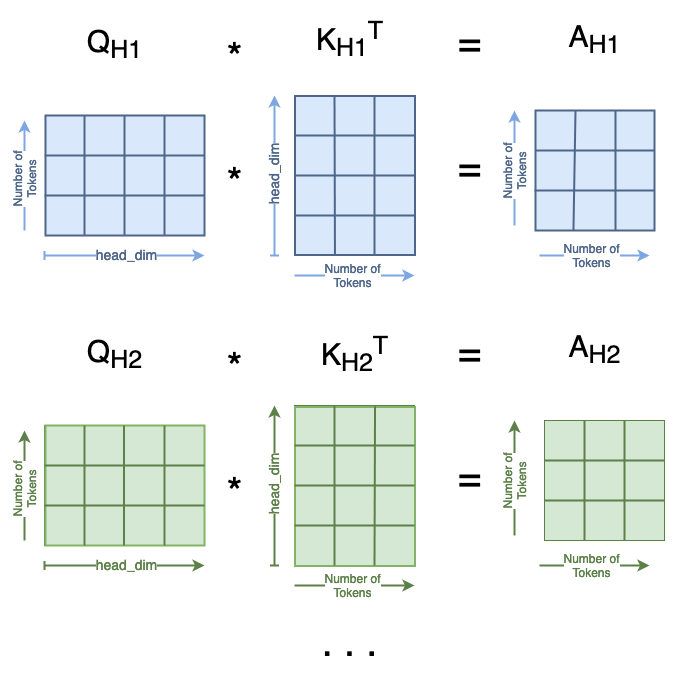
attn = (q * MSA.scale) @ k.transpose(-2, -1)
print('Dimensions for Attn arentbatchsize:', attn.shape[0], 'ntattention heads:', attn.shape[1], 'ntnumber of tokens:', attn.shape[2], 'ntnumber of tokens:', attn.shape[3])
Dimensions for Attn are
batchsize: 13
attention heads: 4
number of tokens: 100
number of tokens: 100
Next we calculate the softmax of A, which doesn’t change it’s shape.
Then, we can compute
This is similarly distributed across the multiple attention heads:
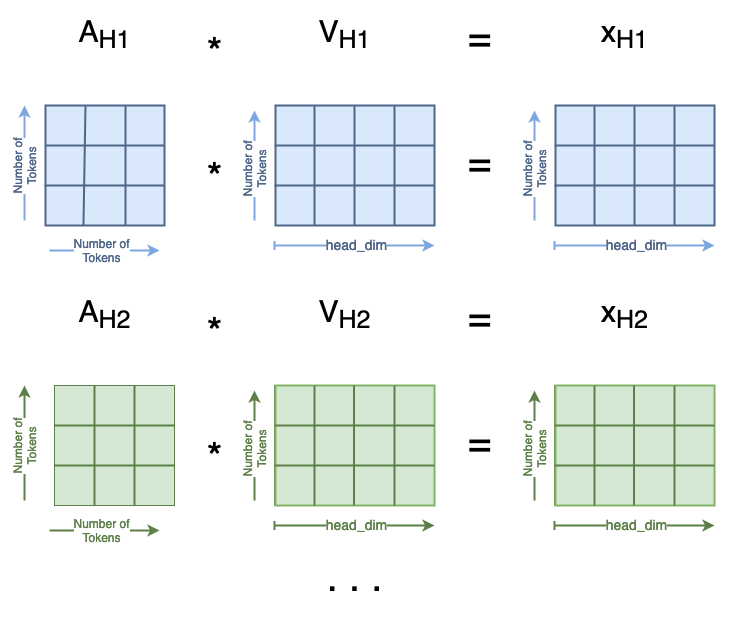
attn = attn.softmax(dim=-1)
x = attn @ v
print('Dimensions for x arentbatchsize:', x.shape[0], 'ntattention heads:', x.shape[1], 'ntnumber of tokens:', x.shape[2], 'ntlength of tokens:', x.shape[3])
Dimensions for x are
batchsize: 13
attention heads: 4
number of tokens: 100
length of tokens: 16
Now we concatenate all of the xₕᵢ’s together through some reshaping. This is the inverse operation from the first step:

x = x.transpose(1, 2).reshape(B, N, MSA.chan)
print('Dimensions for x arentbatchsize:', x.shape[0], 'ntnumber of tokens:', x.shape[1], 'ntlength of tokens:', x.shape[2])
Dimensions for x are
batchsize: 13
number of tokens: 100
length of tokens: 64
Now that we’ve concatenated all of the heads back together, the rest of the Attention module remains unchanged. For the skip connection, we still use V, but we have to reshape it to remove the head dimension.
x = MSA.proj(x)
print('Dimensions for x arentbatchsize:', x.shape[0], 'ntnumber of tokens:', x.shape[1], 'ntlength of tokens:', x.shape[2])
orig_shape = (batch, num_tokens, token_len)
curr_shape = (x.shape[0], x.shape[1], x.shape[2])
v = v.transpose(1, 2).reshape(B, N, A.chan)
v_shape = (v.shape[0], v.shape[1], v.shape[2])
print('Original shape of input x:', orig_shape)
print('Current shape of x:', curr_shape)
print('Shape of V:', v_shape)
x = v + x
print('After skip connection, dimensions for x arentbatchsize:', x.shape[0], 'ntnumber of tokens:', x.shape[1], 'ntlength of tokens:', x.shape[2])
Dimensions for x are
batchsize: 13
number of tokens: 100
length of tokens: 64
Original shape of input x: (13, 100, 49)
Current shape of x: (13, 100, 64)
Shape of V: (13, 100, 64)
After skip connection, dimensions for x are
batchsize: 13
number of tokens: 100
length of tokens: 64
And that concludes multi-headed attention!
Conclusion
We’ve now walked through every step of an attention layer as implemented for vision transformers. The learnable weights in an attention layer are found in the first projection from tokens to queries, keys, and values and in the final projection. The majority of the attention layer is deterministic matrix multiplication. However, the linear layers can contain large numbers of weights when long tokens are used. The number of weights in the QKV projection layer are equal to input_token_len∗chan∗3, and the number of weights in the final projection layer are equal to chan².
To use the attention layers, you can create custom attention layers (as done here!), or use attention layers included in machine learning packages. If you want to use attention layers as defined here, they can be found in the GitHub repository for this article series. PyTorch also has torch.nn.MultiheadedAttention()⁴ layers, which compute attention as defined above. Happy attending!
This article was approved for release by Los Alamos National Laboratory as LA-UR-23–33876. The associated code was approved for a BSD-3 open source license under O#4693.
Further Reading
To learn more about attention layers in NLP contexts, see
- Transformers Explained Visually Part 1 Overview of Functionality: https://towardsdatascience.com/transformers-explained-visually-part-1-overview-of-functionality-95a6dd460452
- Transformers Explained Visually Part 2 How it Works, Step by Step: https://towardsdatascience.com/transformers-explained-visually-part-2-how-it-works-step-by-step-b49fa4a64f34
- Transformers Explained Visually Part 3 Multi-Headed Attention Deep Dive: https://towardsdatascience.com/transformers-explained-visually-part-3-multi-head-attention-deep-dive-1c1ff1024853
- Visual Guide to Transformer Neural Networks Multi-Head & Self Attention Video: https://www.youtube.com/watch?v=mMa2PmYJlCo
For a video lecture broadly about vision transformers (with relevant chapters noted), see
- Vision Transformer and its Applications: https://youtu.be/hPb6A92LROc?si=GaGYiZoyDg0PcdSP
— Human Visual Attention: 4:31 — 5:18 (https://youtu.be/hPb6A92LROc?t=271&si=VMx2lM9lvW-oKcW_)
— Attention as a Dot Product: 5:18–6:14 (https://youtu.be/hPb6A92LROc?t=318&si=pF2SFp2XXjK8AWsL)
— Description of Attention formula: 16:13–17:52 (https://youtu.be/hPb6A92LROc?si=toAgKQCOh9zGCR-c&t=973)
— Why Multi-Head Self-Attention: 19:44–19:58 (https://youtu.be/hPb6A92LROc?t=1184&si=Sy1e149ukt99DoRf)
Citations
[1] Vaswani et al (2017). Attention Is All You Need. https://doi.org/10.48550/arXiv.1706.03762
[2] Dosovitskiy et al (2020). An Image is Worth 16×16 Words: Transformers for Image Recognition at Scale. https://doi.org/10.48550/arXiv.2010.11929
[3] Yuan et al (2021). Tokens-to-Token ViT: Training Vision Transformers from Scratch on ImageNet. https://doi.org/10.48550/arXiv.2101.11986
→ GitHub code: https://github.com/yitu-opensource/T2T-ViT
[4] PyTorch. Multiheaded Attention. https://pytorch.org/docs/stable/generated/torch.nn.MultiheadAttention.html
Attention for Vision Transformers, Explained was originally published in Towards Data Science on Medium, where people are continuing the conversation by highlighting and responding to this story.
Originally appeared here:
Attention for Vision Transformers, Explained
Go Here to Read this Fast! Attention for Vision Transformers, Explained